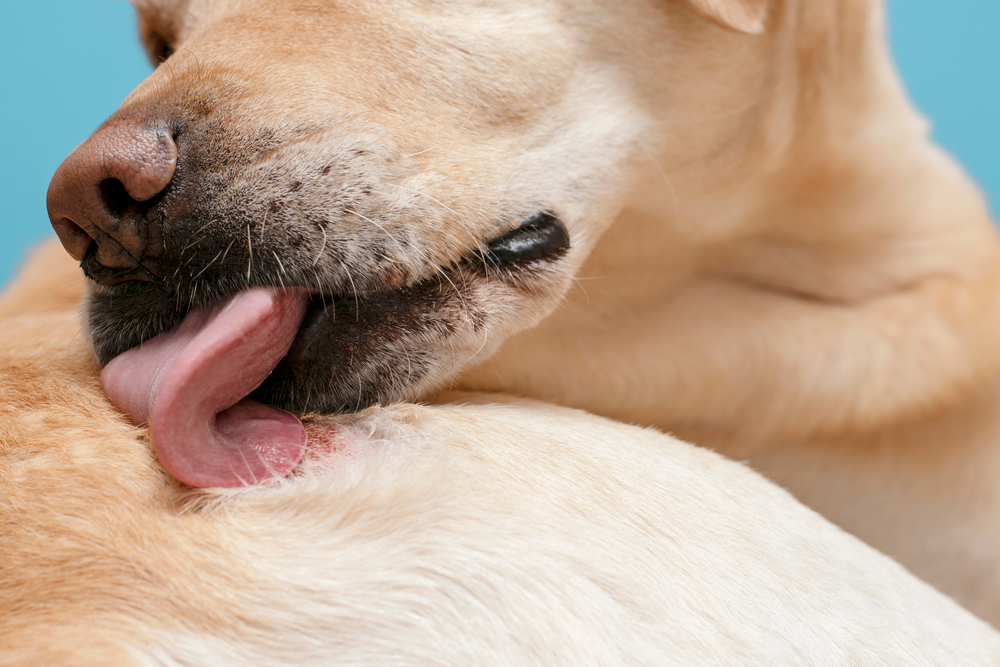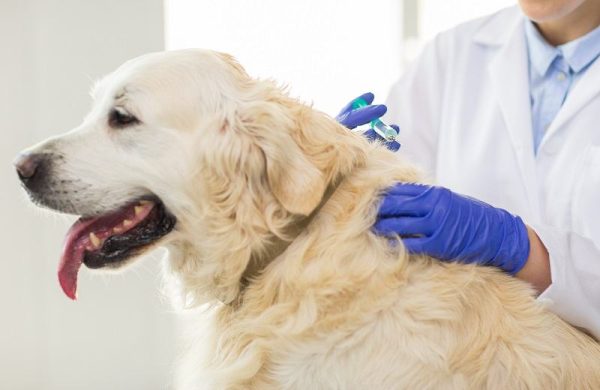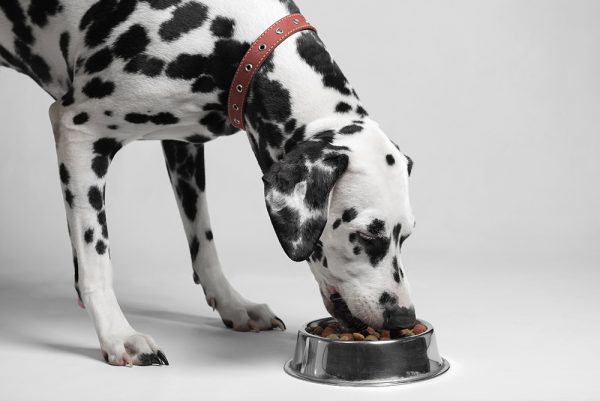In this article
View 5 More +You may have heard the term pyoderma used frequently by your veterinarian around your dog, especially if they have allergies. While any dog can get a bacterial skin infection, otherwise known as pyoderma, it’s seen most commonly in dogs with allergies. You may not even know your dog has allergies until they are diagnosed with pyoderma. Some dogs can get chronic, deep pyoderma that is difficult to treat. Other dogs may only get pyoderma once in their life. Whatever the reason, pyoderma can be a frustrating condition to deal with and treat and is often accompanied by chronic allergy treatment.

What Is Pyoderma?
Pyoderma is a bacterial skin infection. It can be found anywhere on your dog’s body, and can be focal or diffuse. Pyoderma is one of those conditions that may look small and innocent at first, but then quickly progress to significant lesions, hair loss, and discomfort. Pyoderma is most commonly visible to the naked eye though there are rare instances of deep pyoderma that may need advanced testing to diagnose.
What Are the Signs of Pyoderma in Your Dog?
Pyoderma is fairly easy to spot by your veterinarian, especially veterinarians in the southern United States who tend to see a higher prevalence of allergies, though it can occur in any dog in any part of the country. Commonly you or your veterinarian may notice pustules on the skin, which appear to look like little whiteheads. Crusts are also very common and many owners mistakenly think their dog has ringworm, which is actually a fungal infection. Other dogs may have moist pyoderma which will appear as reddened, sticky, moist areas of crusted fur. Moist pyoderma is often in areas such as skin folds, or areas where your dog has aggressively licked/chewed/scratched/itched. Hair loss may or may not be seen depending on the severity and chronicity of the pyoderma.

What Are the Causes of Pyoderma?
As mentioned above, pyoderma is a bacterial skin infection. All skin surfaces, including that of your dog and yourself, contain bacteria. There are normal bacteria that hang out on the skin, in the mouth, etc., all the time. However, sometimes new bacteria are presented to the skin that cause a problem. Other times, the normal bacteria that is present has a change to their environment, causing overpopulation issues.
Trauma to the skin is often the underlying catalyst for pyoderma to occur. For instance, if your dog is aggressively or constantly licking their skin due to allergies, this chronic irritation and moisture may cause small or large breaks in the skin and a change in the skin environment. This will then make it possible for outside bacteria, or bacteria from your dog’s mouth, to be transferred to the traumatized skin and cause infection. Even if your dog is not licking their skin, but it has become chronically inflamed due to allergies, bacteria may hang out and develop an infection. If your dog has a suppressed immune system for any reason, they may be more prone to developing not only a bacterial skin infection, but other infections as well such as a UTI.
Some dogs who have excessive skin folds – Bulldogs, Frenchies, Bloodhounds, Pugs, etc.– may be predisposed to developing pyoderma within these folds. This is due to the excessive moisture build up in these areas, not to mention the chronic inflammation and irritation from these folds rubbing against one another. Interestingly, the same can be seen in obese dogs with skin folds and creases.
By far the most common cause of pyoderma we see is underlying allergies. Allergies in dogs typically cause itchy skin. This includes allergies to things in the environment, contact allergies, flea allergies, and food allergies. When things such as pollen, grasses, and weeds cause us to sneeze and have watery eyes, these same things will cause your dog’s skin to become severely itchy (known as pruritus). Your dog will then start to lick, chew, and bite their skin due to the itching. This irritation, inflammation, and moisture sets up the perfect environment for pyoderma that we discussed above.
Seek veterinary advice if you’re concerned about your pet’s well-being.
If you need to speak with a vet but can't get to one, head over to PangoVet. It's our online service where you can talk to a vet online and get the advice you need for your pet — all at an affordable price!

Diagnosing Pyoderma in Your Dog
Pyoderma is one disease that can sometimes be diagnosed just by appearance. The appearance of a pustule or crust is diagnostic for pyoderma. However, sometimes yeast can cause similar lesions to appear on the skin. Therefore, your veterinarian may prefer to look at a hair and/or skin sample under the microscope for evidence of bacteria. Diagnosing different types of allergies is a much more complicated process and options should always be discussed with your veterinarian based on their history and signs.
If the pyoderma does not seem to be clearing up, or worsens over time, further testing may be needed. Your veterinarian may need to perform tests to rule in/out antibacterial resistance and to find out the exact type of bacteria that is causing the infection.

How Do I Care for a Dog With Pyoderma?
Because pyoderma is a bacterial infection, some form of antibiotics is needed. Period. There are no holistic treatments shown to effectively clear a bacterial infection without antibiotics. There are things that can help, yes. But just like you wouldn’t treat a bacterial pneumonia with holistic therapy, your dog should be prescribed some or multiple forms of an antibiotic to clear a bacterial skin infection.
Antibiotics may be prescribed in the form of oral medications or a long-acting injection. These are known as systemic treatments as they circulate within your dog’s bloodstream. Other times medicated shampoos, wipes, sprays, and/or mousse may be helpful to your specific dog. There are countless formulations out there that may be effective. In addition to some sort of antibiotic, these products will often contain a steroid to help with inflammation, an anti-yeast medication, and even medications to help with oily or dry skin.
Your dog may require multiple products at the same time. Frequently these are prescribed for 2–4+ weeks, depending on the severity of the skin. It’s best to treat past the point of seeing any abnormal lesions. In addition to treating the pyoderma, your veterinarian may also prescribe either an oral or injectable allergy medication for your dog. Year-round flea prevention is always recommended due to the prevalence of flea allergies.

Frequently Asked Questions (FAQ)
Why Didn’t My Veterinarian Treat My Puppy’s Pyoderma?
Puppy pyoderma is a very common finding in areas with very little to no fur such as the groin, belly, and armpits. Puppy pyoderma can often be self-limiting (clear on its own) as long as your puppy and/or other animals in the house do not lick or bother the area(s). Also, many veterinarians do not want to treat puppies with antibiotics unless completely necessary so as not to set up future antibacterial resistance.

Why Does My Dog’s Pyoderma Keep Coming Back?
We see this frequently if the infection either wasn’t treated long enough, the dog was still allowed to lick/chew/bite themselves even while receiving treatment, and/or the underlying allergies were never treated. Just changing your dog’s food but doing nothing for their underlying allergies will not solve the problem. Work with your veterinarian to come up with an effective, long-term treatment plan and then follow through.
Is Pyoderma a Lifelong Issue?
Potentially, depending on the severity of the infection, underlying allergies, and the ability to control clinical signs of the allergies. Some dogs suffer from such terrible allergies that their pyoderma can never be completely cleared. Other dogs have developed significant antibiotic resistance, making treatment of pyoderma difficult. It’s important to know that allergies, no matter the cause, require lifelong monitoring and treatment.

Conclusion
Pyoderma is a bacterial skin infection that we can see in any dog of any age. It’s most common in dogs with underlying skin allergies and can sometimes be difficult to clear. The pyoderma develops due to irritation to the skin (licking, chewing, biting, scratching) with either transfer of bacteria or bacterial overgrowth occurring. Diagnosis can often be made by your veterinarian just by looking at the lesions, however microscopic evaluation is always recommended. Antibacterial treatment is always needed to clear pyoderma which typically will include some type of systemic therapy and often be combined with topical medications. It’s always important to prevent your dog from continuing to lick and chew on themselves. Underlying allergies need to be controlled and treated in order for long term pyoderma care to be successful.
Featured Image Credit: Luiza Kamalova, Shutterstock


















